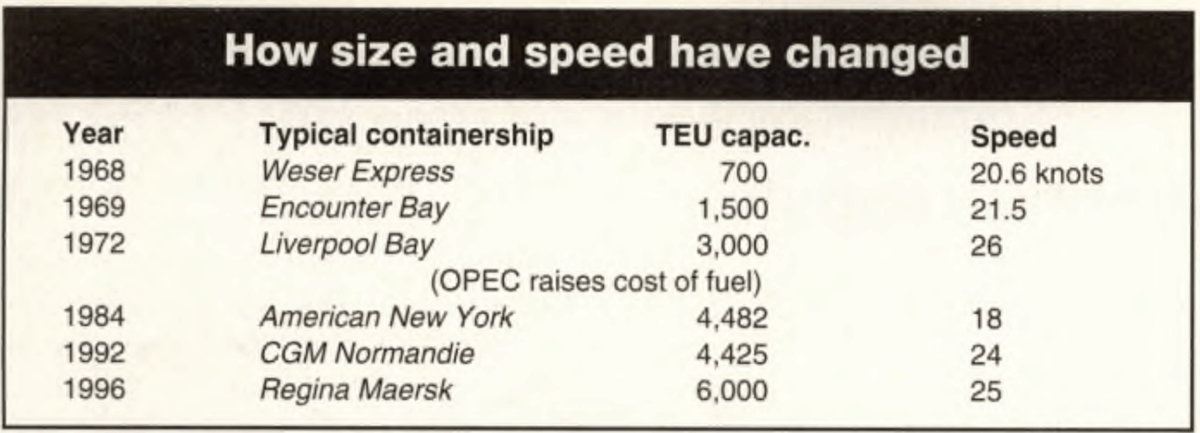
FreightWaves Classics articles look at various aspects of the transportation industry’s history. If there are topics that you think would be of interest, please send them to fwclassics@freightwaves.com.
The many industries that make up the world of freight have undergone tremendous change over the past several decades. Each week, FreightWaves explores the archives of American Shipper’s nearly 70-year-old collection of shipping and maritime publications to showcase interesting freight stories of long ago.
In this week’s edition, from the March 1996 issue of American Shipper (Virtual Pages 42-43), FreightWaves Flashback spotlights Maersk’s ambitious push for containership superiority.
Maersk Line has launched the world’s largest containership, a behemoth that is the first to break the 6,000-TEU mark.
The new 6,000-TEU vessel, Regina Maersk, was launched on January 10 in Maersk’s Odense shipyard in Aarhus, Denmark. The ship is the first of a series of 12 identical vessels, the first nine of which will be deployed in the Asia/North Europe trade.
The vessels symbolize the quest of carriers for scale economics, automation and [immense size]. At 1,044 feet (318.2 meters) long, the new Maersk ships are longer than the Eiffel tower, but they are still capable of a high speed of 25 knots.
“The Regina Maersk is not only the largest container vessel in the world but is also equipped with the world’s most powerful diesel engine,” Maersk said. The engine is rated at 74,640 bhp.
Its total complement of officers and crew will be just 15, compared with 21 for the 4,300-TEU vessels of American President lines that, when built in 1988, were the first post-Panamax containerships.

With a breadth of 140 feet, the new Maersk ships will be far wider than the 106-foot (32.35-meter) maximum width for ships transiting the locks of the Panama Canal.
The new vessels will have a maximum draft of 46 feet, or 14 meters.
Maersk said each of the new ships will have 700 reefer plugs for carrying refrigerated container cargo. The line said the ships would have 20 percent more refrigerated-cargo capacity than the world’s largest dedicated reefer vessel.
Other features include on-deck platforms that the line said would permit safer lashing of containers above deck, and stabilizer fins to minimize rolling in rough seas.
Maersk refused to disclose the gross tonnage of the new ships, as this would allow competitors to calculate the actual TEU capacity of the new ships.
Maersk had initially stated that its new 6,000-TEU ships would have a maximum capacity of 4,800 TEUs and said last April that they would be lengthened to accommodate 5,500 TEUs.
Critics have alleged that the discrepancy between the public figures and the final capacity number of 6,000 TEUs was a calculated move to mislead competitors and to gain a commercial edge.
“During the design stage, it was decided to up the capacity to 5,500-TEU-plus,” Kjaedgaard said. “We never said that it would be just 5,500 TEU.”
Hanjin Shipping, Hyundai Merchant Marine and Cosco have ordered ships with capacities of 5,000 TEU or more, but none has yet placed a firm order for 6,000-TEU juggernauts.
With its ships already built or close to completion, Maersk has a two-year lead over carriers such as P&O Containers and NYK Line, which are still studying potential orders for 6,000-TEU vessels.
Dive into American Shipper’s archives:
FreightWaves Flashback: JFK changing with the times
FreightWaves Flashback: A380 takes airplane competition to next level
FreightWaves Flashback: Study shows Pacific container trade slowing down







